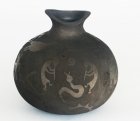I would like to make some miniature bat house ornaments (birdhouse ornaments with orange walls and black roof) but I can't afford ebony for the roof.
How well does black Trans Tint dye work for ebonizing the maple or popular roof? What application method works best?
How well does black Trans Tint dye work for ebonizing the maple or popular roof? What application method works best?





